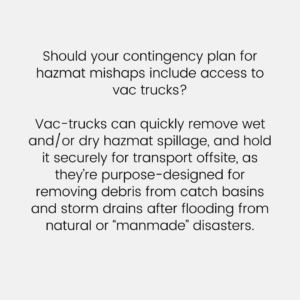Vac Truck Responsibilities for Transporting Hazardous Waste
October 15, 2020
Can a Vac Truck Help Manage Your “Cradle-to-Grave” Responsibilities for Transporting Hazardous Waste?
There are a lot of ways to get moderate amounts of hazardous waste from Point A to Point B. However, if you’re blessed with hundreds or thousands of gallons of hazardous liquid, sludge, or slurry that needs to be safely gotten rid of, then you might want to consider a vacuum truck.
A vacuum truck—affectionately called a “vac-truck” among its American cognoscente—is a truck with a pump and a tank. The pump sucks liquid, sludge, or slurry into the tank so that it can be safely hauled away to its ultimate destination.
Too much information
A deep dive into the internet reveals other names used for vacuum trucks.
- Aussies call them “sucker trucks,” or more graphically, “sewer suckers," demonstrating their penchant for no-nonsense nomenclature.
- More-delicately, they’re called "hydro-vacs" or " vac trucks in Canada, where it’s important to be polite.
- They’re “exhauster trucks” in Rwanda—in case you need to rent one while vacationing there.
- And why they’re called “honey wagons” in India and South Africa: we don’t care to know.
How vac trucks work
The same general principles that allow your household vacuum cleaner to suck up dust; dander are likewise at work in the machinations of a vac truck.
To wit, a powerful pump pulls air out of the tank. A lance connected to the tank is controlled by an open/shut valve. When the lance is pointed at the non-solid hazmat, with its valve opened, the tank equalizes itself with the surrounding atmosphere, creating a vacuum that sucks it all in.
(BTY, “lance” is just a fancy name for “vacuum cleaner tube;” and it’s called the same thing on the family Hoover sitting at-the-ready in your hall closet. So who knew?)
Kinds of vac-trucks
- Liquid vac-trucks are the most common, and are what you probably already imagine: a big truck with a tank on the back and a hose—er, lance—dangling from its back. You’ve probably seen one of these in your neighborhood, in the vicinity of a street sewer.
- Trailer vacs are the little sisters (or brothers) of vac trucks. As you might guess, they’re so-called because a relatively-smaller pump, tank, and lance will show up at your site, riding on a trailer.
- Roll-offs are another version. These are typically rectangular open-top containers on heavy-duty wheels. They’re used for high-density hazardous wastes such as soils, sludges, and ashes.
- Jetters are something else altogether and might be of interest to you after all the hazmat has been cleared from your sewer, catch basin, or whatever. A powerful motor accelerates water to blast residue into the next county: sort of like an angry Home Depot
pressure-washer on steroids.
Your responsibilities
It’s important that any vac-truck company you select has the requisite certifications to collect and haul hazardous waste, and that they are a lot more than simply conversant with relevant OSHA, RCRA, DOT, local, state, and federal regulations—and the documentation thereto.
As we’re wont to advise: get expert advice before proceeding because the training requirements for hazmat transport are onerous. Among them:
- Security awareness training about the security risks associated with hazmat transportation, and specific methods designed to diminish them
- Function-specific training relative to the particular knowledge and skills required for an individual to perform assigned hazmat-transport responsibilities properly and safely
- Safety training for drivers, warehouse workers, and any other employees who handle any hazardous waste in advance, during, and/or subsequent to its transportation
- Specialized driver training pertaining to vehicle inspection and operation; vehicle handling in diverse conditions; and special rules pertaining to tunnels, bridges, and railroads.
- Advanced security training for companies required to have a security plan relative to their hazardous waste management
- HAZWOPER 1 certification for employees who must drive onto hazardous waste sites, enter EPA-regulated TSDF, or respond to hazardous waste emergencies Hazardous Waste Operations and Emergency Response
Summary
Remember that per the EPA, you’re responsible for any hazardous waste you “generate” from “cradle-to-grave.” This includes its transportation from your facility to wherever it will ultimately be treated, stored, or disposed of.
Vacuum trucks can be an effective way to meet this workaday responsibility, and they can be indispensable in the case of an emergency where hazmat needs to be quickly vacated from your site.
Get expert advice here. And thank you for reading our blog!

